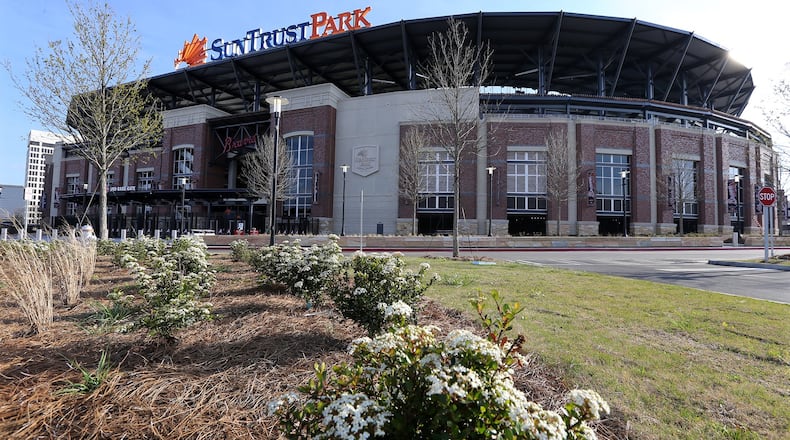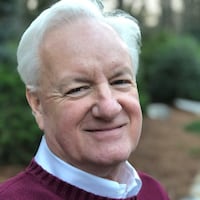The Braves made Atlanta a major league city.
Their first game in Atlanta Stadium on April 12, 1966, helped cement Atlanta’s stature as the Capital of the South. Atlanta had Coca-Cola, Delta Air Lines and Martin Luther King Jr. Now it had The Hammer, Knucksie and what would become America’s Team.
On Friday, the Braves will play their first regular season game at the new SunTrust Park in Cobb County, Atlanta's first top-tier pro team to have its home outside the city limits. Of all the corporate relocations the suburbs have taken at the expense of the city, not one is more symbolic than the Braves.
But there will be lasting changes, too.
The move is already transforming the area around Cumberland Mall. It will also change the face of the neighborhoods around Turner Field, as Georgia State University and private developers convert the old ballpark into a football stadium and build a node of student housing, apartments and retail.
“I think it is one of the most significant events in Atlanta’s geographic history,” said A.D. Frazier, the former chief operating officer of the Atlanta Committee for the Olympic Games, who has witnessed or taken part in more than a few landmark Atlanta moments.
“Atlanta” is still big league — much bigger, in fact than it was 51 years ago — and greater than a single city, encompassing a metro area of more than two dozen counties and nearly 6 million people.
But the blow to the city is more emotional than existential.
Credit: Curtis Compton
Credit: Curtis Compton
“They are not as essential in defining Atlanta’s identity as they were in the 1960s,” Frazier said of the Braves. “But it’s thanks to them that we got started (as a major league city).”
The parting of the Braves from Atlanta comes as the core of the city is on the upswing, stronger and more vibrant than any point in decades. The population of city dwellers is up about 10 percent since 2010 after years of stagnation.
The suburbs, too, are expanding. And metro Atlanta is expected to grow by 2.5 million people through 2040.
When institutions make big moves, the ripples course through history. Atlanta steals the Braves from Milwaukee to a downtown stadium built on spec.
Hank Aaron breaks Babe Ruth’s record. A young Ted Turner buys the Braves and makes the team the cornerstone of his fledgling television empire. CNN is born.
Meanwhile, the South’s new capital expands upward and outward. Its foolhardy aspirations grow international. Thirty years after Atlanta joins the big leagues, it holds the Centennial Olympic Games.
The Games end and the Olympic Stadium becomes Turner Field. When the Braves and Atlanta fail to come to terms on a deal to redevelop the area and stay downtown, the Braves find a new suitor in Cobb.
And 20 years and 10 days after the opening of The Ted, Cobb takes its turn at-bat.
Opening Day, in essence, becomes another inflection point for Atlanta, for Cobb and for the region.
“It’s a move we could not have contemplated five decades ago when the Braves came to town,” said Susan Neugent, CEO of the Fernbank Museum of Natural History. “Atlanta was much smaller and more compact than it is today. Atlanta today is more a city-state than it is a city.”
To some, a great relocation
Bill Bartholomay brought the Braves to Atlanta from Milwaukee in 1966. His ownership group sold the team to Turner in 1976, but Bartholomay, 88, has stayed involved with the team through the years and serves as its chairman emeritus.
What is the impact of the move to Cobb? “It’s not like moving the Braves from Milwaukee to Atlanta, or the Giants from New York to San Francisco, or the Dodgers from Brooklyn to L.A.,” Bartholomay said. “It’s a totally different thing. I think it’s a good location, and I think it’s going to be good for the Braves, and I think Atlanta is going to love it.”
SunTrust Park is designed to survive in a new baseball economy that goes beyond the sales of tickets and hot dogs. The Braves are now in the real estate business, like many other franchises.
The area near Cumberland Mall provided the team with the land to pull off both a new ballpark and a $550 million entertainment district with apartments, a hotel, offices, restaurants, bars and a theater.
Credit: Hyosub Shin
Credit: Hyosub Shin
“If you look around, you see the San Francisco 49ers playing in Santa Clara, the New England Patriots not playing in downtown Boston,” Bartholomay said. “The Texas Rangers have announced a new facility that will be in Arlington (as is their current stadium), between Fort Worth and Dallas. So you don’t have to be right downtown, as long as you’re part of the greater city.”
Asked how important a moment this is in the history of the team, Braves Chairman and CEO Terry McGuirk did not hesitate.
“Given my view over the history, certainly the Atlanta history, I think it as important as anything we have ever done,” said McGuirk, who has been involved with the franchise since Turner bought it in 1976.
The Braves initially sought to find a way to develop the property around Turner Field and renovate that stadium. When “negotiations downtown didn’t work,” as McGuirk puts it, the Braves began looking around, initially thinking in terms of a much smaller mixed-use development than the 1.5 million square feet they have built in Cobb.
“Our fans have never really had anything around a stadium other than parking lots and highways,” McGuirk said, “and one thing we do know is they are craving a place to eat dinner, entertain … (the) kinds of experiences that we’ve never had.”
John Shafer, a Braves season ticket holder for 27 years, is a big fan of SunTrust Park after three recent visits to the stadium, two for preview events and one for an exhibition game.
“If there is a nicer venue in MLB, I would like to see it,” Shafer said. “I absolutely cannot imagine there being a finer ballpark in all of MLB.”
The Braves jaunt across the Perimeter ruptured an unspoken rule of the ITP/OTP (inside the Perimeter/outside the Perimeter) divide: That pro sports belonged intown.
The Braves brought Atlanta its first major pro championship and first victory parade down Peachtree Street. Where will the next be held? Cobb Parkway?
Cobb Commission Chairman Mike Boyce chuckled at that question. He said Cobb commissioners would probably have a few strong opinions on that subject.
“I’d have to referee something that would be very difficult,” Boyce said, adding that the Braves would have a “large vote” in the process.
To others, a ‘shortsighted’ move
Larry Taylor, an Ansley Park resident and season ticket holder since 1979, called the new ballpark “beautiful.” But he said he fears the Cobb location is a mistake.
“My view is that the whole project both from the city of Atlanta standpoint and the Braves standpoint was shortsighted,” Taylor said.
The city, he said, was too focused on finishing a stadium deal with the Falcons and missed the signals that the Braves were unhappy.
“The Braves have missed the demographic shifts,” he said. “People are moving back inward.”
That may play to the advantage of Georgia State and its development partners.
The partners closed on their purchase of Turner Field and its surrounding parking lots in January. The university plans to convert The Ted into a football stadium. A Panthers baseball field will follow.
Credit: Hyosub Shin
Credit: Hyosub Shin
The Carter development company, Oakwood Development and partner Healey Weatherholtz plan retail, student housing, market rate apartments, affordable housing, and office space in parking lots north and east of the stadium.
Turner Field straddles the intown neighborhoods of Summerhill and Peoplestown. Kenyatta Mitchell, a Summerhill resident since 2001 who formerly led a neighborhood association, said she’s excited for what could come with Georgia State and its development partners. Football and college baseball will be big pieces, but sports will not be the sole emphasis.
The football stadium will ultimately hold about 33,000, far less than Turner Field’s 50,000 seats, and there will be about a half-dozen games per year rather than 81. The baseball field will likely seat about 1,500.
“I’d like to see a nice mix of ages, not necessarily just student housing for Georgia State,” she said. Mitchell said she can foresee professors, government workers and young professionals moving in, “to have a good mix of incomes and ages and ethnicities and backgrounds.”
There was little such optimism in neighborhoods around Turner Field when the Braves announced their split with the city. Some of those wounds linger.
“I guess I feel a little bit like an ex-wife and we’re both moving on,” said Rachel Quartarone, who lives with her husband and two sons in Grant Park.
Quartarone said she doesn’t know how often the family will go to games now.
“I guess in the three years since the announcement was made, I see how ultimately it will be a good thing for Summerhill for the Braves to go away,” she said. “They were holding us back. The stadium itself was holding us back from being a neighborhood.”
Overtones of race, opportunism
Former Atlanta Mayor Shirley Franklin went to her first Braves game as a guest of then-Mayor Maynard Jackson in 1974. It was the night Hank Aaron broke Babe Ruth’s home run record.
Franklin said she wishes the Braves well and is glad the team is only moving a county away.
“Too bad the Braves’ lease extended past my term in office,” she said in an email. “I have no idea whether Atlanta could have won the competition against Cobb County, but I speculate the Council and I would have tried.”
She said her son Cabral, who is now deceased, became a season ticket holder several years ago after he married and started a family. Aaron was pleased, she said, when he learned of the family’s love of the Braves.
“Apparently, the fan base in the African-American community was waning,” she said.
The Braves deal with Cobb encapsulated many of the shortcomings of metro Atlanta, critics said.
A megadeal done in secret that will affect hundreds of thousands of motorists every game day. A megadevelopment built eight miles from the nearest rail station.
Many ITP fans felt betrayed, while the move for many outside the Perimeter signaled unlike any before that the suburbs had arrived.
The Cobb deal was mixed with the overtones of race, corporate opportunism and intraregional poaching. White flight had sucked people and wealth from the city for decades, and the Braves were following suit, critics charged.
Bob Holmes, a former state representative, said the Braves moved to the county that more than any other tried to isolate itself from Atlanta. Cobb rejected MARTA in the 1970s, with racial overtones, and like its northern suburban neighbors, exacerbated the balkanization of the region.
“Atlanta had a national image of cooperation,” he said. “But once you get outside the city, that image of cooperation wasn’t there.”
Frazier, the former Olympics executive who has straddled the corporate and political world in Georgia, agreed that the Cobb deal was another sign of the city-suburban divide.
Metro Atlanta still doesn’t have the mechanisms in place to overcome political problems, he said.
Congestion, for instance, crosses all jurisdictional lines, and the county and city governments have not coalesced around solutions to solve them.
"The politics need to catch up with the issues," Frazier said. "This move does help to highlight a point. At some time these previously, seemingly intractable problems of moving people around will have to be solved. This will help lead us to solve them."
In a bit of irony, the Braves, he said, may lead Cobb to approve of transit.
“But I think there’s going to be a lot more pain before we see relief,” he said.
‘Symbolic for a greater Atlanta’
Emory Morsberger, a longtime Gwinnett County developer who often is a voice for regionalism, called the move to Cobb a positive for the region.
“I see the move to Cobb as not something bad for Atlanta but something symbolic for a greater Atlanta,” he said. “The boundaries of what is considered to be Atlanta have expanded.”
Like Quartarone, Morsberger said Turner Field with the Braves was a barrier to redevelopment of the area.
Bill Rogers, the chairman and CEO of SunTrust Banks, Atlanta’s largest, signed a 25-year deal to put the company’s name on the new ballpark.
Rogers said he believes what the Braves are doing is good for all of Atlanta.
“It’s a win for Cobb County and that area,” he said. “It’s a win for Atlanta Braves fans. And it’s a win for Atlanta.”
Asked what makes it a win for Atlanta, Rogers said:
“Because it’s still the Atlanta Braves. I think what’s going to happen at Turner Field now is going to be fantastic. … The opportunity to essentially redevelop and re-energize two parts of Atlanta and maintain a baseball legacy in the city, I just think that defines a double win.”
-- Staff writer Meris Lutz contributed to this article
The Latest
Featured








